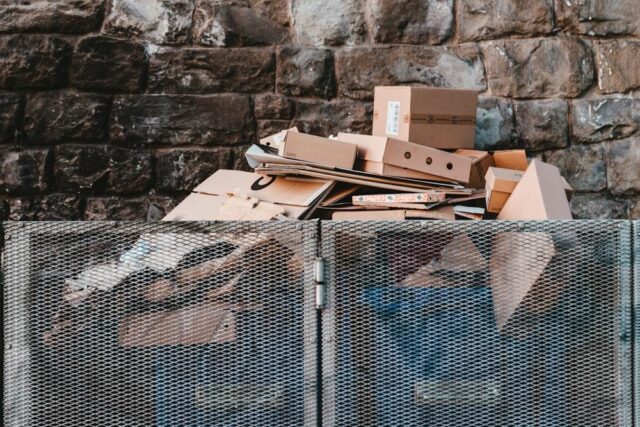Cardboard and plastic packaging were revolutionary at the beginning of the 19th century when the effects of industrialization led to massively rising incomes worldwide and the emergence of advanced technology. Although plastic was more popular than cardboard as it was easier to process and cheaper, they were both reliable options.
Unfortunately, as production became more demanding and consumer trends changed, we’ve triggered a chain reaction of waste settlement in landfills. Most of the plastic isn’t recycled, and over 450 million tonnes of plastic is produced yearly around the globe. Plastic incineration found in landfills pollutes the environment by entering our bloodstreams and the ocean and impacting wildlife and our ecosystems.
While regular consumers contribute to the emergence of waste, companies are accountable for the materials used for packaging, have to minimize their debris, and comply with new environmental regulations. Here are some ways to approach this challenge.
Plastic waste reduction is the most challenging
Unfortunately, plastic is all around us, as it’s the easiest material to use for packaging. Its efficiency can be considered equal to its environmental impact because it’s a significant part of marine litter. Plastic also affects human health since we inhale plastic particles and drink and eat them through plastic-packaged products.
Identifying the amount of plastic in your business is the first step to becoming plastic-neutral. Still, finding alternatives to it is the most critical strategy because minimizing use means less harm to the environment.
For example, you can look for plastic packaging alternatives, such as paper bubble wraps, corrugated packaging, bioplastic, and biodegradable packing peanuts. While the initial cost of development may be higher, your company will reduce packaging costs and improve its brand image by choosing sustainable products over all-plastic ones. Compacting waste plastic is also a great alternative to wasting it.
Why plastic waste management matters
While cardboard waste can contribute to climate change, nothing compares to plastic and its consequences on the planet. Decades of plastic usage led to its expansion in all environments, from oceans, soil, wildlife, and human life.
That’s why reducing plastic use as a business can have a massive impact if it’s adopted globally.
Besides employing sustainability, less plastic means cutting down carbon dioxide emissions, which are known to advance the earth’s temperature by a few degrees. By 2050, the global temperature is set to increase by 1.5 degrees Celsius and up to four degrees by 2100. This will mess up with seasons’ usual behavior, leading to more aggressive storms, heavy rainfalls, and extreme droughts.
All these elements will contribute to destructive diseases and illnesses for both humans and wildlife, whether through the emergence of diseases-carrying insects or by increasing asthma in low-income communities.
Cardboard is recycled, but not enough
Companies leverage cardboard as packaging to use less plastic. While it’s the easiest to recycle, and a consistent portion ends up in the right place, a significant amount is still thrown away in landfills. And, although it’s biodegradable, the space it covers until the soil traps heat absorbs it and can worsen global warming.
There are numerous ways to reduce cardboard as a business, and they can be used only when necessary. For instance, you may want to develop a minimalistic packaging design and make it more efficient to use cardboard as little as possible. You can also reuse all the boxes from shipping.
By far, some of the most labour-saving and energy-efficient methods to reduce cardboard waste include using industrial shredders and balers or compactors. These machines offer various ways to reuse cardboard, such as creating an alternative to bubble wrap or reducing the volume of cardboard waste to reduce collection costs.
The underlying advantages of reducing cardboard waste
Cutting down this type of waste involves much more benefits than just minimizing landfill waste. Considering its lifecycle, using fewer cardboard products leads to less deforestation since trees are the main source of cardboard. More trees support wildlife, improve air quality, and reduce the chances of flooding communities.
At the same time, reusing cardboard instead of producing new products preserves energy, as the process of acquiring it means creating and transporting it, which uses a lot of energy and resources. Moreover, less cardboard is equal to less methane, which is released when cardboard is decomposed.
Other types of business waste to consider cutting down
While cardboard and plastic are prevalent, other types of waste can also be damaging to the environment. General waste is one of them, and it includes products like lamination papers or contaminated packaging that usually need to be appropriately handled. That’s why separating it properly can reduce its chances of ending up in landfills.
Food waste is another considerable accomplice to climate change because it’s a significant part of the greenhouse gas footprint. Producing, transporting, and handling food generates CO2 into the atmosphere, and methane is released when food rots in landfills. The problem with food waste is that businesses don’t have a proper food waste reduction plan, but consumer behaviors are the most damaging in this direction.
Glass waste is also significant, especially since restaurants, hospitality, and glass manufacturers tend to overlook it as wasteful. Glass bottles, plates, and drinking glasses are only a small part of the waste that leads to resource depletion and water pollution. At the same time, glass is difficult to decompose, as it might take even 4,000 years for it to disappear truly.
Finally, hazardous waste is more talked about because its effects on nature are immediate. Businesses that handle flammable or explosive products contribute to a toxic environment, poisoning lakes and the soil. Paint manufacturers, chemical manufacturers, and oil refiners are the main contributors to this situation.
Final considerations
Businesses produce a massive amount of plastic for packaging, but cardboard is close to becoming harmful to the environment. That’s why companies must understand the benefits of cutting it down, including lowering its effects on the human body and helping nature replenish. Still, many other types of waste affect the environment, such as poorly discarded food, glass, and hazardous materials.








